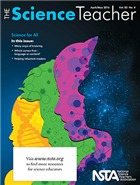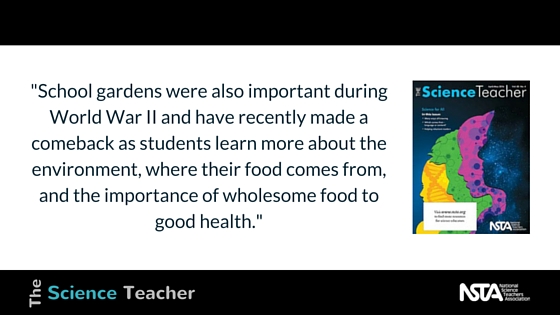Right to the Source: When Schools Fed the War Effort
By sstuckey
Posted on 2016-05-06
Exploring Science and History With the Library of Congress
 After the United States entered World War I in April 1917, citizens could support the war effort by buying war bonds, conserving food on “Meatless Mondays” and “Wheatless Wednesdays,” and consuming less fuel at home and in their cars. Schools helped, too, as students planted vegetable gardens to increase the food supply.
After the United States entered World War I in April 1917, citizens could support the war effort by buying war bonds, conserving food on “Meatless Mondays” and “Wheatless Wednesdays,” and consuming less fuel at home and in their cars. Schools helped, too, as students planted vegetable gardens to increase the food supply.
School gardens, dating to the late 1800s, helped students get fresh air and exercise and learn about nature, which was especially important to city kids. Student gardeners learned about plants, soil, fertilizers, watering, and keeping records to help improve crop yield. They received valuable lessons in botany and entomology by learning the names, anatomy, and life cycles of garden plants and insects; detecting the role of earthworms in soil aeration; watching seed germination; observing pollination by bees and other insects; determining which insects ate which plants; and learning to recognize garden weeds.
During World War I, school gardens let students show their patriotism and support for troops fighting overseas. President Woodrow Wilson approved funding for the United States School Gardens program noting that school gardens were vital to the war effort. This 1919 poster (above) shows Uncle Sam leading an “army” of student gardeners.
School gardens were also important during World War II and have recently made a comeback as students learn more about the environment, where their food comes from, and the importance of wholesome food to good health.
About the Source
During World War I, posters encouraged citizens to modify their eating habits, plant victory gardens, and can fruits and vegetables so that more food could be sent for the war effort. The poster shown here is just one of many from World War I available online from the Library of Congress. To learn more about the school gardens movement, see these Library of Congress resource guides: School Gardens and School Gardening Activities, as well as a guide to related webcasts.
Related Student Explorations
- Botany
- Soil properties
- Gardening
- Nutrition
Danna C. Bell is an education resource specialist at the Library of Congress in Washington, D.C.
Editor’s Note
This article was originally published in the April/May 2016 issue of The Science Teacher journal from the National Science Teachers Association (NSTA).
Get Involved With NSTA!
 Join NSTA today and receive The Science Teacher, the peer-reviewed journal just for high school teachers; to write for the journal, see our Author Guidelines and Call for Papers; connect on the high school level science teaching list (members can sign up on the list server); or consider joining your peers at future NSTA conferences.
Join NSTA today and receive The Science Teacher, the peer-reviewed journal just for high school teachers; to write for the journal, see our Author Guidelines and Call for Papers; connect on the high school level science teaching list (members can sign up on the list server); or consider joining your peers at future NSTA conferences.
The mission of NSTA is to promote excellence and innovation in science teaching and learning for all.
Future NSTA Conferences
5th Annual STEM Forum & Expo, hosted by NSTA
- Denver, Colorado: July 27–29
2017 Area Conferences
- Baltimore, Maryland: October 5–7
- Milwaukee, Wisconsin: November 9–11
- New Orleans, Louisiana: November 30–December 2
National Conferences
- Los Angeles, California: March 30–April 2, 2017
- Atlanta, Georgia: March 15–18, 2018
- St. Louis, Missouri: April 11–14, 2019
- Boston, Massachusetts: March 26–29, 2020
- Chicago, Illinois: April 8–11, 2021
Follow NSTA
Disclaimer: The views expressed in this blog post are those of the author(s) and do not necessarily reflect the official position of the National Science Teaching Association (NSTA).



